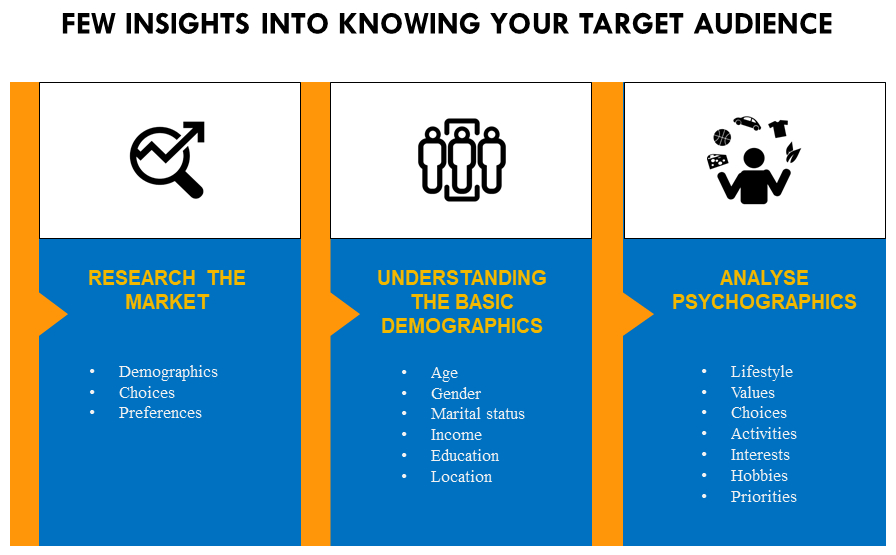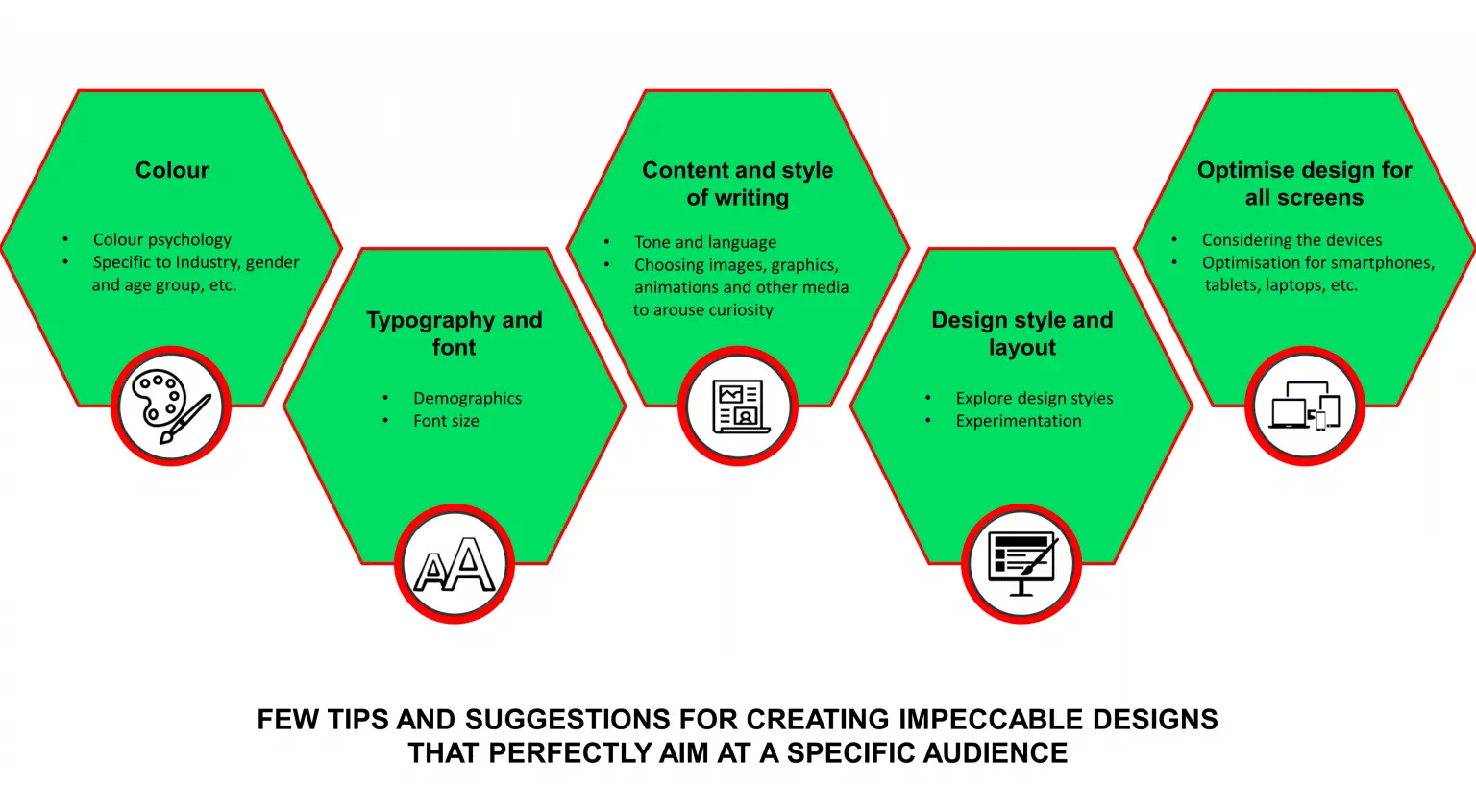
Designing is all about giving life to content. It is a channel of communication;
the creation of an experience that combines various visual & other elements in
an aesthetic way to convey your messages to the audience. So, being a designer
apparently means choosing and blending multiple elements to craft something so
impressive that influences the perception of the audience.
But, what if a designer picks elements like colour, fonts, images and other
graphics to create a design of his/her own personal preference or only by
following the latest design trends in the market? This is where things can go
wrong. Here, one of the most important things to be considered is ignored, the
target audience!
The target audience can be an individual or a group for whom you tailor your
designs. You’ve got to figure out who your target audiences are and put your
efforts into designing for them.
Why design for a particular audience?
The impact of personalised marketing is so big that it brings the best results
across multiple mediums and channels of marketing. Target audiences are the
emperors you serve. You must understand them inside-out, or else the end results
might not generate the positive outcome that you expect.
Whether it’s a web design, graphic design, design for social media or printed
media, the result of your hard work and the incredible designs that you have
made can be of no use if it doesn’t appeal to the audience who you have
targeted. When you know your target audience, you can tailor the designs to
their needs and make them understand why they should purchase your
product/service.
Designing for the right audience is a good business practice that enhances your
overall designing & strategy building skills. The designer can save time &
resources, narrow down options in every design aspect such as colour, font
style, images, shape, layout etc. & design exclusively for whoever he/she
intends the designs to serve. Targeted design ads & landing pages bring in more
clicks and customers. They are tools that increase the chances of attracting the
right leads to your sales.
Here are a few ways to define your target audience and build designs that
connect with them:
Find your target audience & examine their needs

Identifying your target audience is the first step to connecting with them
through your designs. Right from selecting the colour scheme to the layout and
structure, the choice of your target audience determines the design elements you
are going to use. Here are a few insights into knowing your target audience:
Research the market: It is essential to do detailed research on the audience for
whom you are promoting the designs. The result of your research determines what
currently works for you. You’ll have to analyse and discover their demographics,
their choices, what makes them choose you, what products/services they use
etc.
Understanding the basic demographics: To get a clear understanding, dig deep
into the demographics of the targets. Define the targets with broad demographics
such as age, location, gender, marital status, income, education, profession
etc., based on the markets your design will serve.
Analyse psychographics: Demographics can be useful only to a certain extent,
you’ll still have to understand the psychographics of the audience.
Psychographics is nothing other than psychological and cognitive attributes such
as their lifestyle, values and choices. Make a study on their activities &
interests, the platform of choice to view designs, hobbies, values, priorities,
how they think and feel etc. You can extract information by conducting surveys
and polls for your target audiences or you can even collect information from
your existing customers who share similar attributes.
Use Design thinking
Design thinking is an approach where engineers, innovators, designers or other contributors to an organisation spend time thinking from the user’s perspective and are willing to make changes until a problem is solved. For a website owner, this can mean designing a website that is easy to read, understand and navigate. Right from understanding the problem to finding the solution, it is a continuous process, which is full of experimentation, research and collaboration of people & their ideas to create user-centric designs. The designs you make should be delightful enough to surprise the audience. If your designs are for a website, doing so can make them repeat visitors. If you understand their emotions and work according to that, you are more likely to turn visitors into customers. For design thinking to work well, you’ll have to put aside personal interests and then define personas for the target audience, which are discussed below in detail.
Create designs with the help of buyer personas
A buyer persona provides a detailed description of the buyer/target audience. It is a research-based profile that describes their goals, desires, challenges, etc. Creating personas for each type of user is important to make a connection with the targets. Based on their profiles, think about what the buyers will be looking for when they land on your designs. Make an analysis of where they'll find you, how they are going to find you and what action you want them to take. Whether it's lead generation, promoting your brand, or making a sale, you should have a clear picture of your marketing goals, why you are creating the designs, and what the requirements of the buyers are.
Put aside personal interests
While designing for a website or for other areas, it is essential to put aside
personal preferences in favour of what works
best for the customers. It cannot be said that personal preferences are always
wrong or will never work, but acting according
to your personal preferences alone can be a wrong choice. You'll be required to
strike a balance between personal choices and
what the audience will appreciate. What appeals to us may be less enthusiastic
to the audience. So, it's the responsibility of the
designer to put themselves in the shoes of the client and stay focused on the
user's perspective to produce designs that will be a
perfect fit for the target audience.
Leverage design
elements for the target audience

The graphic elements you use in the design should align with the demographics
and psychographics of the audience. If you want to create impeccable designs
that perfectly aim at a specific audience, here are a few tips and suggestions
that can be used as guidelines:
Colour: Colour is an important element of every design. There is a theory of
colour psychology, which almost all designers use to evoke reactions and
emotions from the audience. The theory is based on emotions, which can be
experimented with in your designs, however, that is not the only process. For
trendier folks, crazy colours can be attractive, but for an elderly audience,
something simple like the pastel should work. Colours are interpreted
differently by every industry, gender, age group etc. You should reach a good
conclusion from your research. The ultimate goal is to get the people to
move.
Typography & Font: Typography and font are other important elements that express
brand identity. Use typographical elements according to the demographics. For
example, kids usually love funky and cartoony fonts, while designs for a
corporate website usually showcase a kind of serif font. Likewise, font size is
another important factor that requires consideration while making designs.
Content & style of writing: The interest of audiences can be influenced by
content and style of writing. The tone and language to be used in the design can
vary according to the audience. For example, a friendly tone is perfect for
health & lifestyle based designs, while something conservative would work for
the designs intended for an insurance company. In the same way, choose images,
graphics, animations and other media that are relevant or that will arouse
curiosity among the viewers.
Design style & Layout: There is a wide range of design styles like vintage,
artistic, contemporary, minimalist, traditional etc. to choose from. You can
explore them and conduct a little bit of experimentation to understand what will
be a perfect choice.
Keeping up with the latest trends is a great way to stay focused on your target
audience.
Optimise design for all screens: If your designs are for online media, then you
will have to consider the devices used by the audience. The design elements need
to be optimised for different screens such as smartphones, tablets, laptops
etc.
Order your information hierarchically
Visual hierarchy is an important aspect of all designs. It just gives an order
of importance, how the visual elements are positioned and displayed. Arranging
your information in order by surfacing what’s more important and filtering out
less important elements will make an effective piece of design. As a designer,
you’ll have to figure out what the audience looks for the most when they see a
design, so that you can make the important features brighter, bigger, bolder and
catchy while leaving the second important things smaller or below the eye level.
These are just basics to ensure that whoever sees the design gets the main
points or the information that they expect.
Test your designs
You need to ensure that your designs are fit for the target audience. Test your
designs to see if your message is really and easily understandable. For that,
you can use different approaches like beta testing, a/b testing (comparing two
versions of something to find out which is better) or testing your designs with
colleagues and peers. After testing is completed, analyse the results and make
adjustments as per test results.
Examine your competitors
It’s common for businesses to take a look at their competitors to see what
strategies they have adopted and how they are performing. By evaluating the
competitions, you’ll be gaining a deep understanding of the market trends, what
they have in common, what’s going to work and what’s not going to work. It’s not
like you are going to copy them, instead, you seek out inspiring designs,
content, optimization, layout and even the strengths, weaknesses and
opportunities to gain a strategic advantage in this field. By doing so, you are
going to be the game-changer who can tell a story through your designs in a way
that helps the audience see what you can provide better than your
competitors.
Creating successful designs begins with identifying your target audiences and
their needs. The more you can identify them, the deeper you can get an idea of
what they want and then build designs catering to their requirements. Designing
for your target audience will help you set clear goals and devise plans
accordingly. Both patience and practice are important here, but once you’ve hit
the jackpot, you’ll be confident to create winning strategies and enthralling
designs that will leave your audience amazed.




CONTACT US